Methodology for Learning Mathematics Based on Collaborative Work with the Support of ICT Tools and Virtual Environments of the UCN Campus
by Carlos Esteban Huerta Briones * ![]()
North Catholic University, Department of Mathematics, Antofagasta, 1240000, Chile
* Author to whom correspondence should be addressed.
Journal of Engineering Research and Sciences, Volume 1, Issue 4, Page # 81-86, 2022; DOI: 10.55708/js0104011
Keywords: Training process, evaluation, feedback, collaborative learning, mathematics
Received: 20 February 2022, Revised: 12 March 2022, Accepted: 13 March 2022, Published Online: 12 April 2022
APA Style
Briones, C. E. H. (2022, April). Methodology for Learning Mathematics Based on Collaborative Work with the Support of ICT Tools and Virtual Environments of the UCN Campus. Journal of Engineering Research and Sciences, 1(4), 81–86. https://doi.org/10.55708/js0104011
Chicago/Turabian Style
Briones, Carlos Esteban Huerta. “Methodology for Learning Mathematics Based on Collaborative Work with the Support of ICT Tools and Virtual Environments of the UCN Campus.” Journal of Engineering Research and Sciences 1, no. 4 (April 2022): 81–86. https://doi.org/10.55708/js0104011.
IEEE Style
C. E. H. Briones, “Methodology for Learning Mathematics Based on Collaborative Work with the Support of ICT Tools and Virtual Environments of the UCN Campus,” Journal of Engineering Research and Sciences, vol. 1, no. 4, pp. 81–86, Apr. 2022, doi: 10.55708/js0104011.
The article indicated basically showed the autonomous collaborative work of the students and no direct reference was made regarding the work in remote classroom, this time what is presented is a methodology of direct work of the teacher with the students during the teaching sessions, which last 60 minutes in times of pandemic, which allowed to establish more solid bases for both direct and indirect work of students from the point of view of their learning. The lecture sessions were developed following the following scheme: Active-participatory class, Collaborative Activity with the support of the teacher and Assistantship would complete. Regarding the evaluations and qualifications, these were carried out considering processes of direct feedback to the groups formed as indicated in. The evaluations were carried out through the Moodle-based platform of the UCN Virtual Campus, which considered, multiple choice questions, short answer and a development exercise.
1. Introduction
The work that is presented incorporates actions and activities for the learning of mathematics of first-year students of the university, within which is developed in the article “Methodologies of collaborative learning and peer evaluation in virtual educational environments”[1].
The continuation of the pandemic forces all teachers to implement adaptations and improvements in learning strategies during distance classes, even more than studies show, according to [2]. Students conceive that teacher are not prepared for the virtual context in which classes take place, they perceive activities as tasks that accumulate; adding to this a poor communicative quality, either by the connectivity or by the form of expression of both actors [3]. Regarding the participation of students during distance classes, this is very scarce to say nothing, only some of them participate or consult with monosyllables through chat, rarely a student participates through their microphone. In any case for students, intervening directly in this type of classes is equivalent to going out to the blackboard in a face-to-face class. By virtue of the above is that we implemented a modality of classes that achieved a better participation by the students, in fact, the students were grateful to be able to develop exercises immediately during the classes and thus also for the implementation of the feedback processes of the applied evaluations. It is important to note that the subject where this model was applied was the subject of Calculus.
I for students recently entered the university to careers in Engineering. 2 parallels were formed with 35 and 37 students respectively, so it was necessary to train and guide in the work to be done to the second teacher who taught the indicated subject, in this sense it was important to have previously elaborated a didactic planning of the subject. The topics that were worked on in this symbol were: Inequations, Conics, functions and differential calculus.
2. Ease of Use Applied methodology model
To improve the participation of the students it was important to show examples and propose related exercises to be developed by them with the support of the teacher and end with an assistantship work that in the training process sought to consolidate what was developed during the recently finished class.
For the subject of assistantships, we had the support of the academic success program that the university has, they assigned us two assistants as tutors, one for each parallel, who worked with the students in the third block of 30 minutes and supported the autonomous collaborative work of the students following the guidelines indicated in the aforementioned article.
Coordination meetings were held between teachers and assistants, in order to properly guide the work to be done and specify what their role was in this new way of working. They were provided with the guides for collaborative work and didactic planning, in which the links to be used are found.
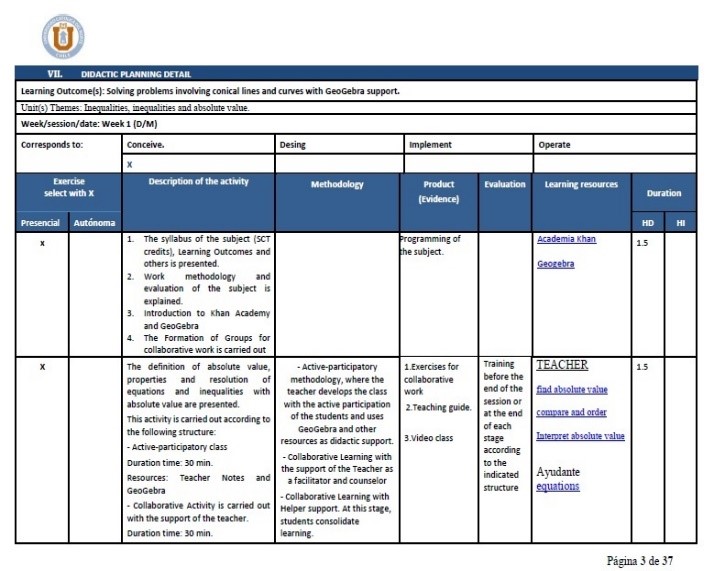
It is valid to note that in the traditional model of face-to-face classes and the current program of the subject contemplates 2 sessions of chair and a session of assistantship, regarding the assistantship both in the face-to-face and at a distance, finally the teacher ends up doing all the exercises and the effect on the student in terms of learning is ineffective and the role of the students is passive, which goes in the opposite direction to the guidelines declared in the institutional educational project.
On this occasion we carried out the 3 sessions as a chair with the exception that the last 30 minutes were dedicated to an assistantship, this fact was key to the consolidation of the students’ learning, since they immediately reinforced what was developed during the chair.
This class model was developed according to the following 3 stages:
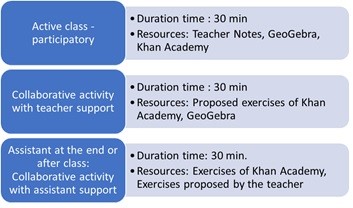
3. Evaluation process
The evaluation of the learning process has always been a complex process [4], above all, because it has a very relevant influence on the quality of the process. If we do not evaluate correctly, learning will not be of quality and we will have lost a lot of time and resources to not achieve the main objective of such learning [5].
The above makes note how complex the evaluation process is in general and particularly in online modality classes, in this regard several questions arise in relation to who is really answering the evaluation, there is no control during this process, in addition to the fact that there is a large number of applications that solve the mathematics exercises with enough details.
Along with the rest, it must be considered that online evaluation processes, unless developments are requested, in questions of alternatives only final results are requested, which does not allow evaluating the development processes that students carry out to reach the final result.
In conclusion, it is not possible to identify precisely what the student really knows and what mathematical skills, in this case, he handles with a reasonable capacity.
In response to the above, we implemented an evaluation process that would identify the achievement of students’ learning, as indicated in the program of the subject, among others the following are defined:
- Solve problems involving conical lines and curves with the support of GeoGebra.
- Determine bijectivity and its implications in a real variable function.
- Calculate limits of real functions involving indeterminate forms.
- Determine continuity of real functions in a variable.
- Calculate the derivative of real functions in a variable.
- Interpret the derivative in physical and geometric problems.
- Interpret the graph of real functions in a variable with the support of GeoGebra.
- Solve problems of optimizing real functions in a variable.
The work and creativity to elaborate questions that evidence the achievement of the learning, turns out to be an arduous and very extensive work in the elaboration of this type of questions. That is why we chose to carry out a process of presentations that would allow the students to show how they arrived at the results they marked as a correct alternative in this type of questions.
The general idea was to show what the students really knew, the truth that we could only incorporate development questions, however, the interest of insisting on this type of questions, was the feedback process that was generated in the instances of questions and answers when the students had to expose and thus justify their choices.
This instance allowed the student to identify their errors and thus be able to correct them, in a large case and I would say that it was very recurrent the fact that the students marked the alternative that was closest to the result that they reach when developing the exercise, without clearly identifying which was the error that did not lead to the correct answer, well this instance allowed them to correct and receive from the teacher the corresponding feedback.
This process was framed in the evaluation as an instance for learning and that was very well received by the students, stating that it allowed them to improve and learn from their own mistakes.
For each evaluation, a set of different questions was elaborated that measured the same thing, that is, batteries of questions of the same type were made that appeared randomly for different students.
Below are images of some questions elaborated and considered in summative assessments.
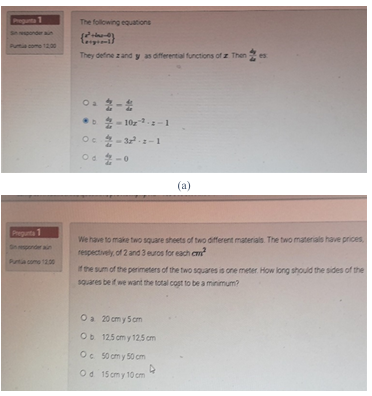
4. ICT tools and virtual environments of the UCN campus
In the reflection of Ortega and Casillas “Critical perspective of the impact of ICT in the educational context”[6], a different perspective of the use of ICT is addressed by questioning the real impact that technology has had in the educational field. By dismantling some myths created around the use of these technologies, the authors lead us to the understanding that ICTs are not by themselves the infallible solution to all kinds of problems.
Specifically, in the field of education, they show how it is not possible to place all hopes in technologies to solve educational problems. They claim that technological instruments alone will not improve work within the classroom; a greater effort is required that considers training and content aspects that involve the participants. According to the reflection, it is true that the use of ICT does not generate learning by itself, but that the appropriate, strategic use and how it is used contributes to the understanding of students during the teaching sessions that are taught. Now, in the times of pandemic that we are living, we were forced to use ICT in the training process of students. In our case, the use of GeoGebra contributed significantly in the understanding of the topics discussed, for example, the following problem was developed in the unit of Conics:
“Determine the equation of the circumference passing through the center of the conic x2 +y2 – 2x- 2y + 1 = 0 and its center is in the center of the parabola x2 = 8y.”
In face-to-face classes this type of exercises for students implied a greater complexity when solving them and generally they could not finish it, in fact, when this exercise was proposed to current students, they could not do it algebraically, however, by making the graphs with GeoGebra they could better analyze the exercise and managed to solve it. The fact of having the graphic resource facilitated the analysis and passage from an abstract context to a friendlier context, where they were allowed to see more clearly the way to find the solution.
Notwithstanding the above, the teachers also developed the exercise analytically in such a way that the students had both forms of solution. In any case, the final reflection of the students is that the exercise was simpler than it seemed. In this sense, graphic mathematics contributes to the understanding of the topics to be discussed.
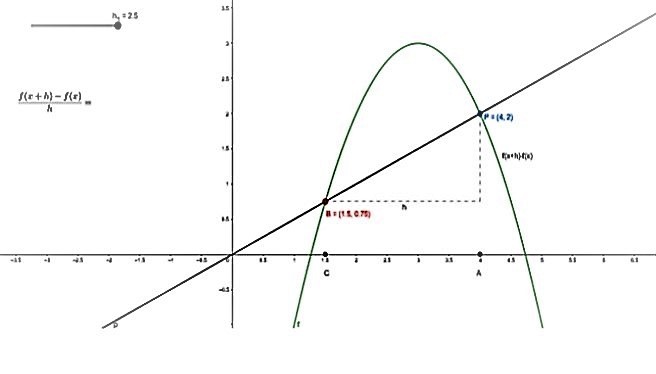
Another classic and important topic of differential calculus is the geometric interpretation of the derivative, to present this topic the teachers elaborated in GeoGebra an interactive activity that allowed the students to intervene modifying parameters and thus visualize the geometric meaning of the derivative relating it to the delivered definition of the derivative [7].
The new virtual platform based on Moodle that was implemented at the university was a great contribution to the application of evaluations and their respective correction in the case of development exercises. Important, in addition, the writing in latex for the language of mathematics, facilitated the teaching work and improved the means of communication with the students, in this platform all the links of Khan Academic that were used in each class were uploaded.
Interactive activities were incorporated for student support, as well as all recorded classes [8].
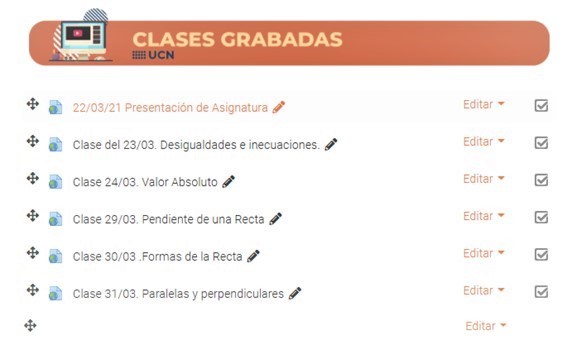
In respect of Khan Academic, of this platform, the proposed exercises that they have in each topic that the subject required were used. The exercises were selected according to the need to carry out practices immediately during the class of chair and during the collaborative work carried out by the teacher and by the assistant, all these links, as already mentioned, were incorporated into the didactic planning of the subject. Another important contribution of this platform is that, if a student makes a mistake in an exercise, it offers help with specific indications or with an explanatory video associated with the topic being evaluated [9].
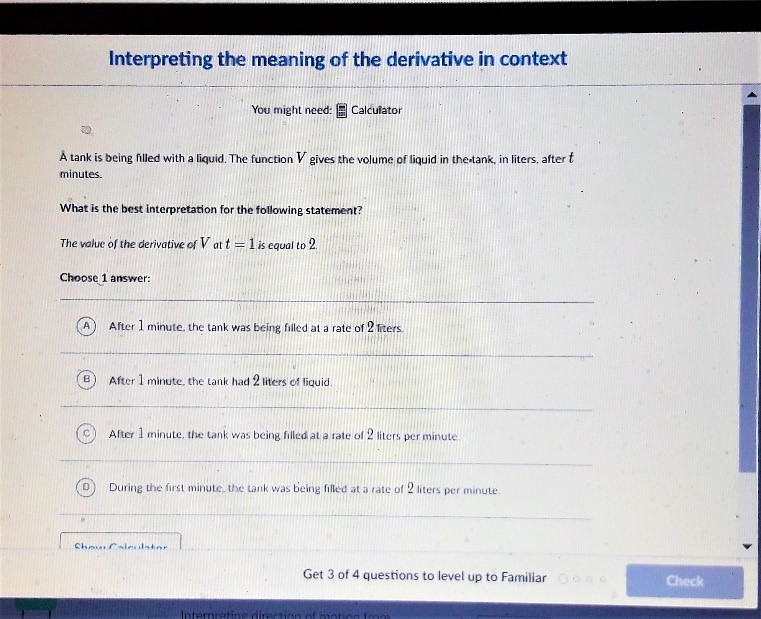
5. Results
5.1. Closing survey
To know the opinion regarding the innovation implemented in the subject of calculus I, a mixed type questionnaire was developed with closed and open questions, addressing the following areas in its elaboration: the first of them considering the time of dedication to the subject, a second area of general perception of the methodology, a third aspect regarding the disposition to study in the subject and finally an evaluation of the activities developed during the semester.
Closed questions were asked through Five-level Likert scales and 10-level semantic differential.
The survey was carried out through a Google form and applied once the subject was finished, for this the questionnaire was shared on the virtual campus platform of the University.
5.1.1. Time of dedication to the subject
According to the answers of the group of students, they dedicate between 9 and 5 hours a week to the signature, mentioned that only 3% of them dedicate 9 hours, being the lowest percentage of voting. On the other hand, 83% of the sample dedicates between 5, 6 and 7 hours, which translates into 31% who dedicate 5 hours, 28% who dedicate 6 hours and 24% who dedicate 7 hours, which according to what is defined in the subject.
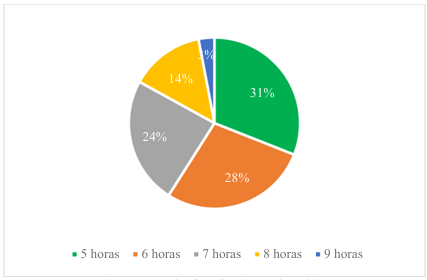
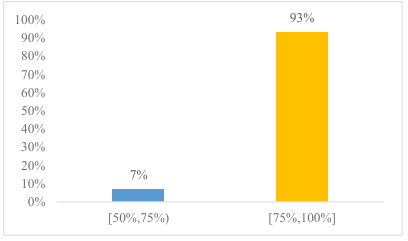
5.1.2 Attendance Percentage
Of the total number of students who responded to the survey, 93% of them declare to attend classes in an average attendance of 75% to 100% while in a smaller percentage with 7% it does between 50% and 75%.
5.1.3 Evaluation of collaborative work
In relation to the learning experience in the subject, a 4-level assessment scale is proposed, describing whether this experience was a good, very good, regular or bad experience, resulting in 34% of them considering it very good, while 45% rated it at a “good” level, only 21% as regular and none of them as a “bad” experience. That is, 79% of them generated a positive evaluation of the learning experience.
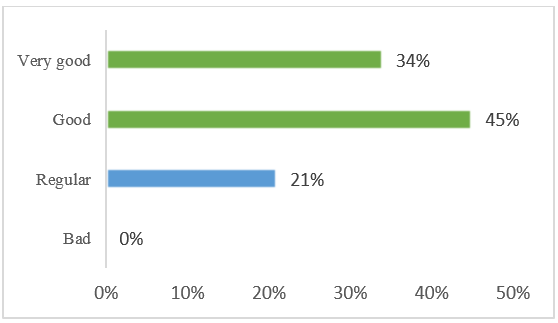
Then a numerical assessment of the experience is requested, considering a scale of 1 to 10 points, 31% of them rate it with 10, 28% with 9, 10% with 8, 17% with 7, 10% with 6 and 4% of the answers with a rating of 4 points. Considering the scores greater than or equal to 7, 86% of the answers are located, while only 14% of the answers do so with a score of 6 and 4 points.
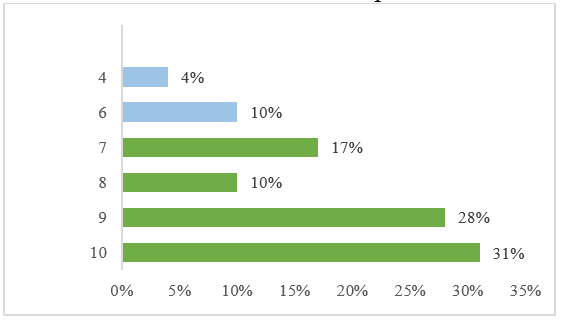
When consulting regarding the reasons for the score, they comment on different factors regarding the assessment, among them they mention some problems associated with the coordination and equity of the work between students, as well as mention positive aspects of the score mentioning that there are academic benefits, collaboration in learning, time organization, a good relationship with the teacher and a good use of the platform Khan Academy.
5.1.4 Arguments mentioned by the students
Communication problems between students
- Lack of communication with the group
- My group never attended classes
- Lack of notice, that surveys influence grades
Equity and coordination of work
- Equitable, to the point that a guide could be done only by me.
- Since there was not much group work on the part of my team except for some group mates.
- It’s hard to work with people you’ve never worked with before
- As such it is not a bad idea to work that way in a group, but even so you do not work in an “intense” way, the fact that everything is online is a complicated issue to carry and whether we want or not that hinders the work on the part of the students as on the part of the teachers.
- It all depends on the people who touch you in the group
- In theory the collaborative work methodology is good, but in the implementation, there are details that are not always ideal. Such as the fact that not everyone participates, or that there are delays in the delivery of tasks.
- It always depends on the group members the experience in general
- There are times when teamwork was not
Academic benefits
- I had classmates who explained to me when I did not understand some exercises, they were orderly and, on the exercise, guides I find that their contents were complete and useful.
- At first, I had a hard time working with my group, but once organized, it was quite a good experience and we were productive according to the group work plan proposed by the teacher.
- Having a group with which to do work and help each other in case we have doubts has helped me a lot.
- Because I feel that it is somewhat easier to work as a team and share your knowledge and help each other.
- The collaborative work was a different way of being able to understand the subject since there are colleagues who help each other, in addition to allowing them to study before a test.
- I find that it helps too much when it comes to studying, the assigned classmates fulfilled their tasks, plus there was a fairly fluid communication.
- The teacher answers all the doubts that appear and, in my group, we work very well and collaborate all.
Relationship with the teacher
- The teacher is very good
I like the result obtained I thought the result obtained
- Was very decent
Complications
- Good methodologies employed, however, with some complications in the course.
Use of platform
- Because it was possible to understand the subjects and practice of methods through Khan Academy
5.1.5. Learning perception
As for the self-assessment of the learning, the lowest response scores are found in the item associated with the previous learning of the subject, while the highest of the scores is assigned to the item associated with each teacher in charge, obtaining a score of 4.1 points.
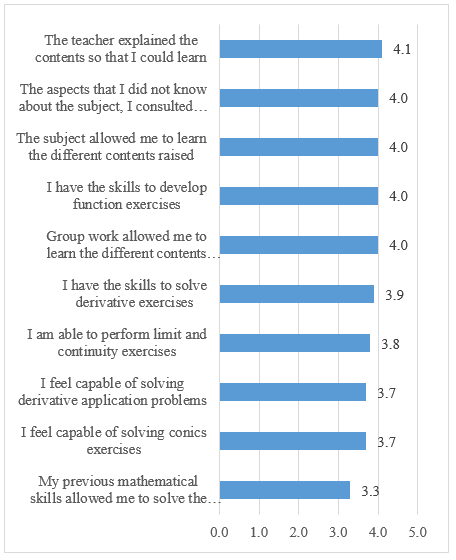
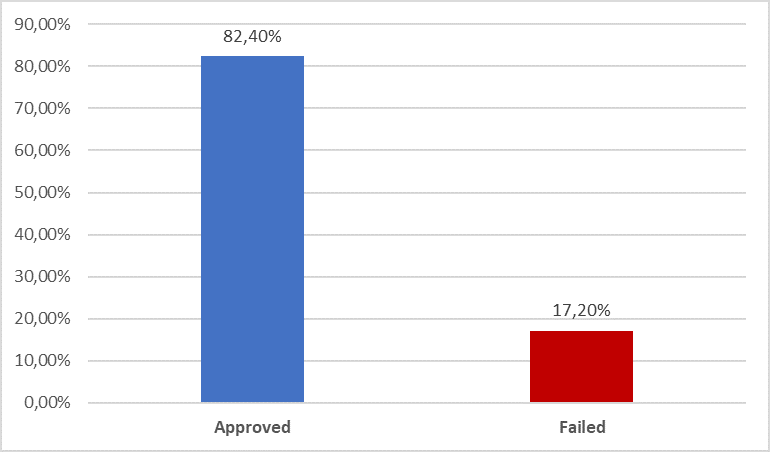
5.2. Overall Performance
Considering the two parallel courses, the total number that participated in this subject were 72 students and whose general results are shown in the following graph:
Finally indicate that the average course grade was 5.4 on a scale of 1 to 7.
- C. H. Briones, C. Pon Soto, “Collaborative learning methodologies and peer assessment in virtual educational environments”, Proceedings – International Conference of the Chilean Computer Science Society, SCCC, vol. 2020-Novem, 2020, doi:10.1109/SCCC51225.2020.9281201.
- J. A. Miguel Román, “La educación superior en tiempos de pandemia: una visión desde dentro del proceso formativo”, Revista Latinoamericana de Estudios Educativos, vol. 50, no. ESPECIAL, pp. 13–40, 2020, doi:10.48102/rlee.2020.50.especial.95.
- S. Tejedor et al., “Education in times of pandemic: Reflections of students and teachers on virtual university education in Spain, Italy and Ecuador”, Revista Latina de Comunicacion Social, vol. 2020, no. 78, pp. 1–21, 2020, doi:10.4185/RLCS-2020-1466.
- T. York, et.al, “Defining and measuring academic success”, Practical Assessment, Research a.alnd Evaluation, vol. 20, no. 5, pp. 1–20, 2015. DOI: https://doi.org/10.7275/hz5x-tx03.
- D. Camacho, C. Alarcón et al. “Educación superior en tiempos de pandemia”. Ciencia Latina Revista Científica Multidisciplinar, vol. 5, pp. 13955–13968, 2021 doi:10.37811/cl_rcm.v5i6.1368.
- J. Ortega, M. Casillas. Perspectiva crítica del impacto de las TIC en el contexto educativo. En A. Ramírez y M. A. Casillas, Háblame de TIC: Tecnología digital en la Educación Superior, pp. 71-84, 2014. Córdoba, Argentina: Brujas. ISBN: 9789875914223
- J. Pabón , Z. Nieto Sánchez, C. A. Gómez Colmenares, “Modelación matemática y GEOGEBRA en el desarrollo de competencias en jóvenes investigadores”, Revista Logos, Ciencia & Tecnología, vol. 7, no. 1, 2015, doi:10.22335/rlct.v7i1.257.
- M. Rizo Rodríguez, “Aprendizaje con MOODLE”, Revista Multi-Ensayos, vol. 4, no. 8, pp. 18–25, 2019, doi:10.5377/multiensayos.v4i8.9448.
- A. Salvatierra , S. Romero, L. Flores, “Khan Academy: Fortalecimiento del aprendizaje de Cálculo I en estudiantes universitarios”, Propósitos y Representaciones, vol. 9, no. 1, 2021, doi:10.20511/pyr2021.v9n1.1042.
